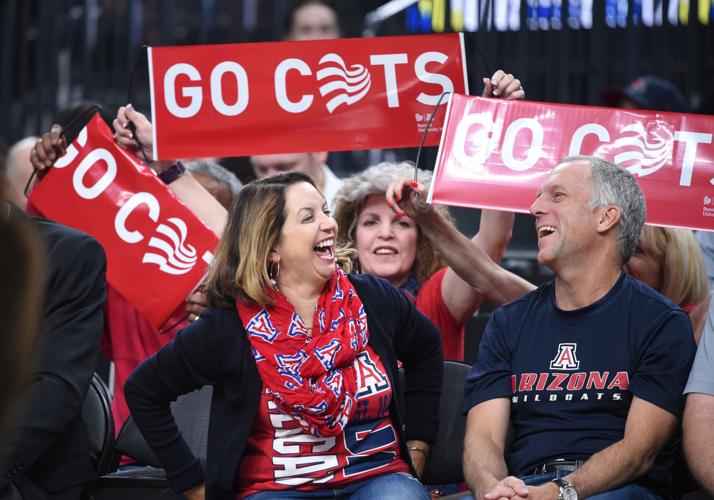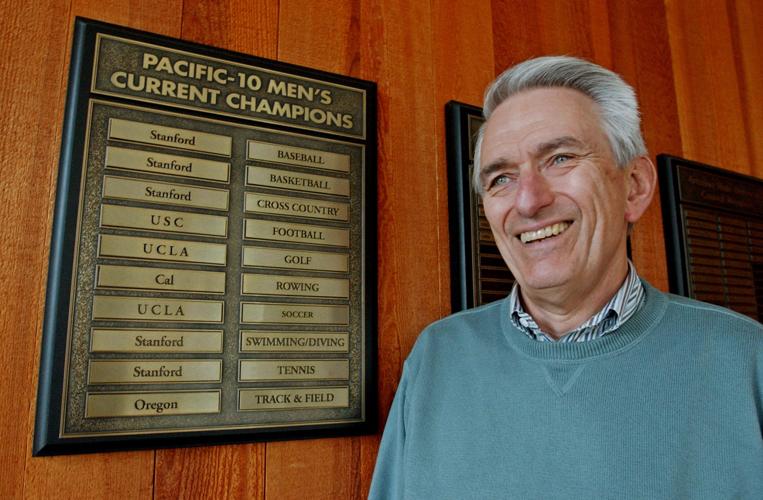No person in Pac-12 history has been criticized more than former commissioner Larry Scott. Not a coach, not a player, not even love-him-or-hit-the-mute-button TV analyst Bill Walton.
Before Scott became commissioner in 2009, his predecessor, Tom Hansen, was an anonymous, behind-the-scenes, watch-the-budget old-schooler who flew on commercial flights — he once had the middle seat next to me on a Southwest flight to Phoenix — and often walked alone into the media room to chat with reporters and get some free popcorn.
By comparison, Scott famously stayed in a $7,500-a-night Las Vegas suite at the 2019 Pac-12 Tournament, an agreement that included use of a butler.
Let’s just say Scott didn’t walk through the door or a media room unless accompanied by several handlers for the purpose of what often turned out to be a talk-down-to-the-audience Q&A session.
As different as the two men are, one inaugurated the Pac-12 Tournament, while the other sustained it and moved it to a higher level in a more compelling neighborhood.
It was Hansen who created the first Pac-10 men’s basketball tournament in 1987, a learn-as-you-go-project that began at UCLA’s Pauley Pavilion, moved to McKale Center, returned to Los Angeles to the Forum and died a slow death at ASU in 1990.
What did Hansen learn? That the Pac-10 didn’t care much for basketball. He canceled the tournament after host ASU drew just 4,567 and 4,380 for the first two rounds of the ‘90 tournament at whatever the Sun Devils then called their dreary arena.
The 1990 championship game — Arizona routed UCLA — drew just 9,478 fans, probably 9,000 of whom were Wildcat fans.
It was a good call. The league’s two prominent coaches, Lute Olson and Stanford’s Mike Montgomery, were outspoken, declaring the tournament to be inessential. (In a later era, Scott might’ve fined the coaches $25,000 for speaking the truth.)
Hansen mostly agreed and didn’t move to resume the tournament for a dozen years, 2002, at which time a network TV contract and use of the Staples Center in downtown L.A. made it more profitable.

Former Pac-10 commissioner Tom Hansen had the right idea when it came to a postseason basketball tournament; it just took a while for it to come together.
What was ironic was that in 1990 ASU pulled off what remains the biggest upset in the tournament’s often-blah history that year in Tempe.
The eighth-seeded Sun Devils stunned Sports Illustrated’s college basketball player of the year, Gary Payton, and his top-seeded Oregon State Beavers, 83-75. It was a night that the Sun Devils were led by former Canyon del Oro High School point guard Mike Redhair, who outplayed Payton (Redhair had eight assists.)
I can’t recall much blowback from eliminating the tournament. Olson was happy, and it’s not an exaggeration that from 1988-2005 he probably had as much clout in the Pac-10 as the commissioner.
But once Hansen got a TV partner and a long-term agreement with Staples Center, the tournament resumed, although it lacked a must-see component.
In Los Angeles from 2002-12, the hometown UCLA Bruins won just two tournament championships and Arizona one (2002). Wildcat fans mostly stayed away during the transition to Olson’s retirement and the hiring of Sean Miller.
By then, Scott had replaced Hansen, and it was at that time that Scott made two of the best decisions — two of the few — of his troubled 13-year rule: He added Colorado and Utah to the conference, and he moved the Pac-12 Tournament to Las Vegas, first to the MGM Grand and in 2017 to the chichi T-Mobile Arena.
McKale North was born. The Pac-12 men’s basketball tournament is now the place to be. Attendance has been as high as 18,927.
I can’t believe I’m typing this, but thank you, Larry Scott.

No one in Pac-12 annals has been criticized more than former commissioner Larry Scott, but he got at least one thing right: Moving the conference basketball tournament to Las Vegas.
About the only thing missing from the tournament’s Las Vegas tenure is deep-dish drama. Six times in the first nine years, the championship game was a predictable No. 1 seed vs. No. 2 seed. Another year it was No. 1 vs. No. 3.
Cinderella stories? Go back to 1990. Fifth-seeded Oregon State’s surprise title in 2021 was played without fans in the arena, an uneven, forgettable season in which neither UCLA, Arizona nor Oregon reached the finals.
What makes this year’s Pac-12 Tournament a must-see event is that the second-ranked Bruins might have their best team since the school’s 1995 national championship. That is compounded by UCLA’s announced exit to the Big Ten in 2024. Such variables have created an urgency to see a basketball blueblood while you can.
Moreover, no one can be certain where and in what league Arizona will be playing a 2025 conference tournament.
UCLA and Arizona are the only true “basketball schools’’ in the Pac-12. By 2025, the Pac-12 Tournament might not be any more appealing than the Mountain West Conference Tournament, played just down the street at UNLV’s Thomas & Mack Center.
Perhaps in ‘25 the MWC title game, let’s say Boise State v. New Mexico, might outdraw the Pac-12 title game between, say, Colorado and Washington State.
But for now, McKale North beckons. If all goes well, Arizona and ASU will collide in Friday’s semifinals. Tipoff is 9:30 p.m., Tucson time. It might be one game that’s worth staying up late to see.







